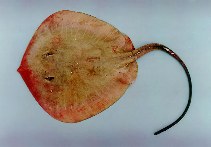| Family: |
Dasyatidae (Stingrays), subfamily: Dasyatinae |
| Max. size: |
62 cm WD (male/unsexed); max.weight: 6,000.0 g |
| Environment: |
demersal; freshwater, potamodromous |
| Distribution: |
Southeast Asia: endemic to the Mekong River (Cambodia and Thailand); introduced to Chao Phraya River (Thailand). |
| Diagnosis: |
Dorsal spines (total): 0-0; Dorsal soft rays (total): 0-0; Anal spines: 0-0; Anal soft rays: 0-0. Distinguished from the other stingray species in the Mekong basin by the presence of a ventral and a dorsal skin folds on the tail and the bright orange color of the ventral surface of the disc. The middle disc is whitish with scattered large orange spots. The dorsal surface of the disc is brown (Ref. 27732). Disc longer than wide; tail longer than body (Ref. 12693). Lacking caudal fin; with long whip-like tail (Ref. 43281). |
| Biology: |
Obligate freshwater stingray that occurs over sandy substrate in large rivers. Feeds on bottom-dwelling invertebrates (Ref. 12693). Ovoviviparous (Ref. 50449). Marketed fresh (Ref. 32457). |
| IUCN Red List Status: |
Endangered (EN); Date assessed: 25 January 2021 (A2bcd) Ref. (130435)
|
| Threat to humans: |
harmless |
Source and more info: www.fishbase.org. For personal, classroom, and other internal use only. Not for publication.

